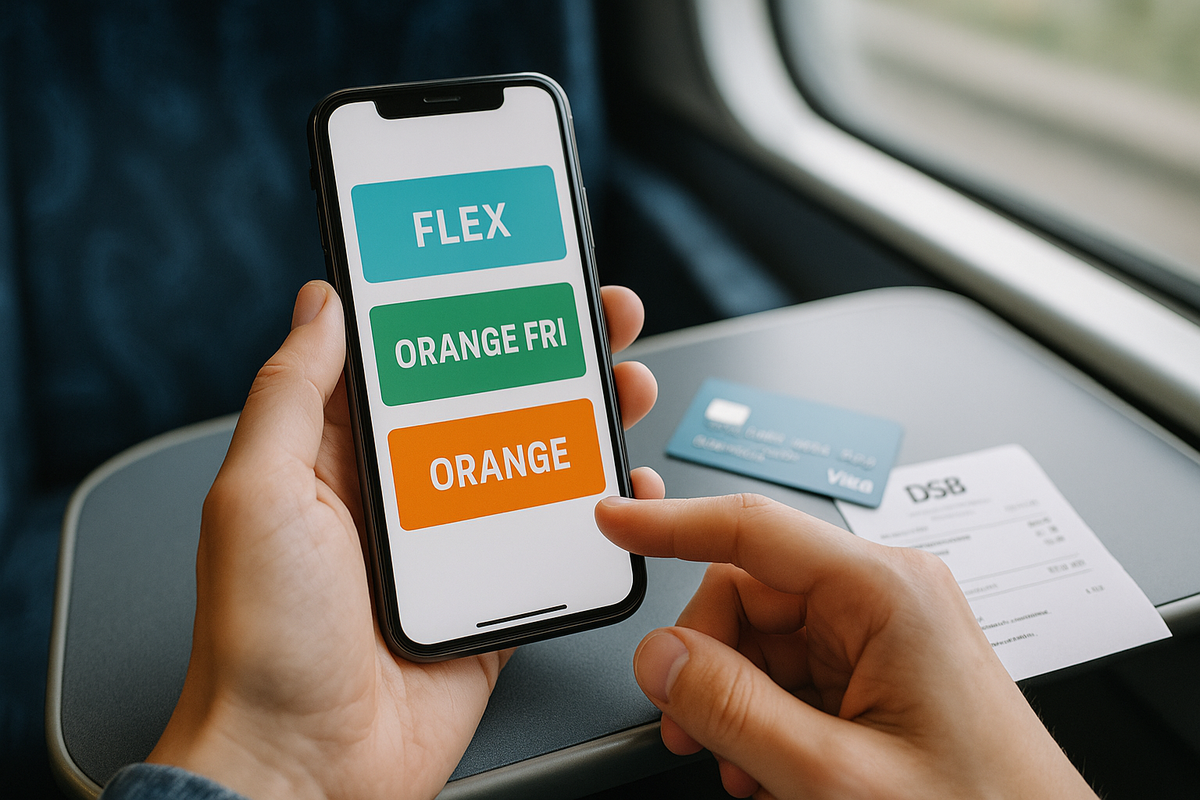🎫 DSB Orange tickets: how to get the lowest prices for trains in Denmark
DSB trains between Copenhagen, Aarhus, Odense, Aalborg and other cities are the backbone of Denmark's transport system, but the basic Flex fare can easily break the family budget.
However, DSB has a system of ‘orange’ tickets (DSB Orange and DSB Orange Fri) that can significantly reduce the cost of travel — if you understand how they work and how they differ from regular tickets.
Many tourists and expats have heard the word Orange, but do not fully understand when these tickets become available, how far in advance they need to be purchased, and what restrictions apply to returns and departure times.
Below, we will break down the mechanics: what this product is, when to look for it, where the real savings are, and in which scenarios it is better not to chase the lowest price.
🔹 What are DSB Orange and DSB Orange Fri?

🟧 DSB Orange: maximum savings, minimum flexibility
DSB Orange is a limited pool of discounted tickets for a specific train and a specific departure time.
Key features:
- the ticket is valid strictly for the selected journey;
- the number of Orange seats is limited; after they are sold out, only regular fares are available;
- the less popular the time and the earlier you buy, the higher the chance of seeing a low price;
- as a rule, no changes are allowed, or the conditions are very strict (in essence, ‘you bought it and you have to take that specific train’).
This is analogous to a classic non-refundable airline ticket: cheap, but with no room for error in terms of time.
🟠 DSB Orange Fri: a compromise between price and flexibility
DSB Orange Fri is more expensive than the regular Orange ticket, but usually significantly cheaper than the fully flexible Flex fare. Typical product logic:
- the ticket also comes with a discount compared to Flex, but
- allows changes before the train departs (according to DSB rules: with an additional payment of the difference and/or a small commission);
- convenient for those who want to save money but are not ready to be ‘locked in’ to a strict schedule.
In practical terms: Orange is ‘minimum price, no manoeuvres’, Orange Fri is ‘discount + reserve for life’.
🔹 When and where to look for ‘orange’ tickets: timing and seasons

🕒 How far in advance to look
Orange and Orange Fri tickets go on sale in advance and are subject to dynamic pricing:
- for popular intercity routes (Copenhagen–Aarhus, Copenhagen–Odense, Copenhagen–Aalborg, etc.), the first ‘orange’ tickets can be seen a few weeks before the trip;
- As the train fills up, the cheapest slots disappear and the remaining ones become more expensive — a classic ‘price ladder’.
If you have already purchased your plane tickets and your travel dates are fixed, it makes sense to check DSB immediately for Orange/Orange Fri availability for your desired route.
📅 Which days offer a higher chance
Conditionally ‘green’ windows for hunting Orange:
- midweek (Tuesday–Thursday) instead of Friday/Sunday;
- departures in the middle of the day, rather than early morning or evening rush hour;
- periods between holidays and major holidays, when domestic traffic is lower.
‘Red’ periods when Orange is either unavailable or very limited:
- Friday trains from Copenhagen and Sunday return trains;
- Christmas and Easter seasons, school holidays, major festivals, matches, concerts;
- morning and evening flights on Monday/Friday for popular business destinations.
📲 Where to look
- Search for tickets via the DSB website or app.
- Immediately enable the Orange / Orange Fri filter to see the difference from the regular fare.
- Play around with departure times by ±1–2 hours and, if possible, dates by ±1 day — sometimes a single ‘step’ in time can result in significant savings 💡.
🔹 Real savings and key restrictions

💸 Where the savings are particularly noticeable
For distances such as Copenhagen–Aarhus or Copenhagen–Odense, the difference between Flex and a well-timed Orange ticket can be tens of percent of the ticket price. For a couple or family, this is no longer a ‘cosmetic’ difference, but a tangible saving for the whole weekend.
A typical scenario:
- Flex = the most flexible but most expensive ticket;
- Orange Fri = a significant discount while retaining the option to make changes;
- Orange = the cheapest ticket if you are sure of your departure time and there are no connections with flights/ferries.
A hypothetical example of the logic (without reference to specific prices):
| 🎫 Ticket type | 🔄 Flexibility | 💰 Price relative to Flex* |
|---|---|---|
| 🎟️ Flex / Standard | Changes and refunds possible | 100 % |
| 🎟️ DSB Orange Fri | Changes allowed before departure | ~70–85 % |
| 🎟️ DSB Orange | No / minimal changes | ~40–70 % |
*Percentage ratios are approximate, but reflect the basic idea: the stricter the conditions, the lower the price.
⚠️ Restrictions to keep in mind
Orange (classic):
- the ticket is strictly tied to the selected train;
- if you miss the train, the ticket is essentially ‘burned’ and you must purchase a new one at the current price;
- refunds are either impossible or practically unprofitable.
Orange Fri:
- changes are allowed before departure, but according to DSB rules (usually with a surcharge to the current price of a similar ticket);
- refunds and changes after departure are usually not possible.
Hence, the main conclusion for planning:
- when connecting with a plane or ferry, it is better to either allow for a significant buffer or opt for a more flexible fare;
- in winter, when storms, delays and cancellations are possible, a ‘strict’ Orange ticket at the last minute is an additional risk for your budget and nerves.
🔹 Practical scenarios and checklist: how to use Orange without any hassle

🧳 Scenario 1: tourist for 3–5 days
You arrive in Copenhagen and want to visit Aarhus or Odense, for example. The best approach:
- First, fix your flight dates.
- Then check DSB for these dates: is there Orange/Orange Fri on trains that are convenient for you?
- On the day of arrival/departure, allow a buffer of at least 2–3 hours between the plane and the train (especially in the cold season).
- If you can't make a buffer, it's wiser to pay extra for a more flexible fare than to take a risk with Orange.
🏠 Scenario 2: you live in Denmark and travel around the country frequently
For expats and residents of the country, the strategy is different:
- monitor Orange immediately after sales start for the ‘right’ dates (weekends with friends, events, visits to family);
- be ready to adjust your plans to take advantage of good prices (for example, leave on Thursday afternoon instead of Friday evening);
- for less rigid plans, choose Orange Fri so that you have the option to change your departure time.
✅ Checklist before purchasing DSB Orange / Orange Fri
Before clicking ‘buy’, ask yourself a few pragmatic questions:
- Do I have enough time? If the train connects with a flight or ferry, is there a buffer, or is everything tight?
- Do I need the option to make changes? Are my plans fixed, or is it possible to shift by a couple of hours/another train?
- What are the risks associated with the season and weather? Is it winter, storm season, frequent delays — or a calm shoulder season without extreme factors?
- How many people are travelling? Saving a couple of hundred kroner per person can add up to a significant amount when travelling 2+2 👨👩👧👦.
- Which is more expensive — saving on a ticket at any cost or maintaining flexibility? Sometimes a slightly more expensive but flexible ticket is more profitable if something goes wrong.
A healthy approach to DSB Orange is not to ‘hunt for the lowest possible price’ but to balance savings and manageable risks. In this case, ‘orange’ tickets are not a trap, but a working tool that helps both tourists and permanent residents travel comfortably and sensibly around Denmark.
❓FAQ
💬 DSB Orange is tied to a specific train, hardly ever changes, and is significantly cheaper than the flexible Flex fare.
💬 DSB Orange Fri is usually cheaper than Flex, but allows you to change your ticket before the train departs according to DSB rules.
💬 It makes sense to check the availability of Orange/Orange Fri tickets a few weeks before your trip and immediately after purchasing your plane tickets.
💬 The best prices are most often found in the middle of the week, during the day and late non-peak hours, outside of holidays and major holidays.
💬 It is worth avoiding it when you have tight connections with a plane/ferry, during the stormy season in winter, and when it is important to be able to change your departure time.





0 comments
Log in to leave a comment